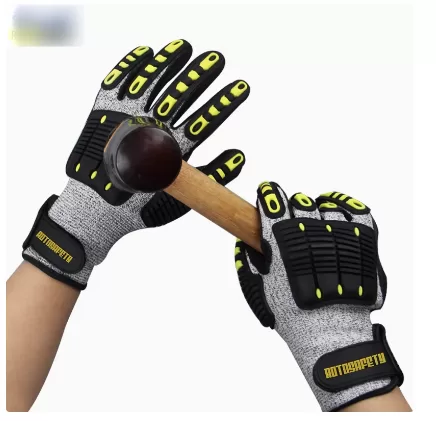I. Material Characteristics
1. Characteristics of TPR Material
- TPR is a thermoplastic rubber material, which combines the elasticity of rubber with the processing characteristics of plastics. This material has good flexibility and can maintain its physical properties under different environmental conditions. For example, it won’t become brittle like some common plastics in a low-temperature environment, nor will it soften excessively in a high-temperature environment, thus ensuring the normal use of the gloves.
- It also has excellent wear resistance. When the gloves are used in scenarios where frequent contact with rough surfaces is required, such as carrying building materials on construction sites or handling thorny plants in gardening work, the TPR material can effectively resist friction, reduce the wear on the surface of the gloves, and extend the service life of the gloves.
2. Overall Material Composition of the Gloves
- Besides the main anti-collision TPR part, the inner layer of the gloves usually adopts soft fabric materials, such as cotton or polyester fiber. These materials can provide a comfortable touch and absorb the sweat on the hands to keep the hands dry. For example, when wearing gloves to work for a long time, the cotton inner layer can prevent discomfort caused by sweating on the hands.
- Some TPR anti-collision gloves are also designed with elastic materials, such as spandex or rubber elastic bands, at the wrist part to better fit the wrist and prevent dust, debris, etc. from entering the inside of the gloves.

II. Anti-collision Design and Principle
1. Distribution of Anti-collision Areas
- TPR anti-collision gloves generally have anti-collision areas set at key parts such as fingers, the back of the hand, and the palm. The TPR protection on the fingers can effectively prevent the fingers from being injured when accidentally bumped or squeezed. For example, in mechanical maintenance work, when fingers accidentally touch hard machine parts, the TPR protective layer can play a cushioning role.
- The anti-collision design on the back of the hand is mainly to deal with possible impacts from behind. In some sports activities, such as boxing training (not professional competition gloves) or extreme sports, the TPR protection on the back of the hand can reduce the impact force and protect the bones and joints of the hands.
- The TPR material on the palm can provide additional protection when grasping heavy objects or encountering collisions in the direction of the palm. For example, when workers are loading and unloading goods, their palms may be squeezed by the goods, and at this time, the TPR anti-collision gloves can play their anti-collision function.
2. Anti-collision Principle
- When TPR material is impacted, it will undergo elastic deformation to absorb and disperse the energy generated by the impact. It doesn’t directly transfer the impact force like hard plastics but cushions through its own deformation. For example, when an object impacts the TPR anti-collision gloves at a certain speed, the TPR material will be compressed, and its internal molecular structure will change, converting the impact force into elastic potential energy and storing it. Then, after the impact ends, it will return to its original shape and release the stored energy. This process of energy absorption and release effectively reduces the impact force transmitted to the hands, thus protecting the hands from harm.
III. Application Scenarios
1. Industrial Field
- In automobile manufacturing factories, when workers assemble automobile parts, they may come into contact with various metal parts and tools. TPR anti-collision gloves can prevent the hands from being bumped and scratched. Meanwhile, in some positions that require operating heavy equipment, such as stamping workshops, the anti-collision function of the gloves can also reduce hand injuries caused by accidental movements of machines.
2. Construction and Decoration Industries
- Construction workers can be well protected when carrying bricks, stones and other heavy objects or using tools such as hammers and electric drills. Decorators can also avoid hand injuries due to accidental collisions when installing doors, windows, ceilings, etc.
3. Outdoor Sports and Recreational Activities
For example, in mountain biking, cyclists may fall during the ride, and when their hands touch the ground, TPR anti-collision gloves can reduce the impact force generated by the collision between the hands and the ground. In skiing, the gloves can also protect the hands when falling or colliding with other skiers. In addition, some adventure enthusiasts will also use TPR anti-collision gloves to prevent their hands from being scratched or bumped by rocks, branches, etc. during outdoor activities such as rock climbing and jungle crossing.



